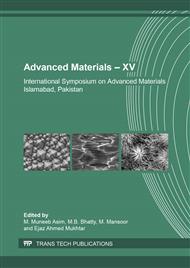[1]
S. Chattopadhyay, Y.F. Huang, et al, Anti-reflecting and photonic nanostructures, Mater. Sci. Engineer., 69 (2010) 1–35.
Google Scholar
[2]
C. Ballif, J. Dicker, et al, Solar glass with industrial porous SiO2 antireflection coating: measurements of photovoltaic module properties improvement and modeling of yearly energy yield gain, Sol. Ener. Mater. Sol. Cel., 82 (2004) 331–344.
DOI: 10.1016/j.solmat.2003.12.004
Google Scholar
[3]
P.K. Chang, P.-T. Hsieh, et al, Improvement of the short-circuit current density and efficiency in micromorph tandem solar cells by an anti-reflection layer, Th. Sol. Fil., 520 (2011) 550–553.
DOI: 10.1016/j.tsf.2011.06.086
Google Scholar
[4]
J.D. Hylton, et al, Alkaline etching for reflectance reduction in monocrystalline silicon solar cells, J. Electrochem. Soc., 151 (6) (2004) G408–G427.
DOI: 10.1149/1.1738137
Google Scholar
[5]
K.R. McIntosh, T.G. Allen, et al, Light trapping in iso-textured silicon wafers, IEEE J. Photovolt. 7 (2017) 110–117.
Google Scholar
[6]
S.Sivasubramaniam, M.M. Alkaisi, Inverted nanopyramid texturing for silicon solar cells using interference lithography, 2014, Published by Elsevier B.V. Microelectronic Engineering.
DOI: 10.1016/j.mee.2014.04.004
Google Scholar
[7]
J.Y. Chen, K.W. Sun, Enhancement of the light conversion efficiency of silicon solar cells by using nanoimprint anti-reflection layer, Sol. Ener. Mater. Sol. Cel., 94 (2010) 629–633.
DOI: 10.1016/j.solmat.2009.11.028
Google Scholar
[8]
J. Escarre, K. Söderström, et al, Geometric light trapping for high efficiency thin film silicon solar cells, Sol. Ener. Mater. Sol. Cel., 98 (2012) 185-190.
DOI: 10.1016/j.solmat.2011.10.031
Google Scholar
[9]
M. Jošt, S. Albrecht, et al, Back-and Front-side Texturing for Light-management in Perovskite/Silicon heterojunction Tandem Solar Cells, Energ. Proced., 102 (2016) 43-48.
DOI: 10.1016/j.egypro.2016.11.316
Google Scholar
[10]
C.J. Ting, M.C. Huang et al, Low cost fabrication of the large-area anti-reflection films from polymer by nanoimprint/hot-embossing technology, Nanotechnol., 19(2008) 205301 (5pp).
DOI: 10.1088/0957-4484/19/20/205301
Google Scholar
[11]
J. K. Tsai and Y. S. Tu, Fabrication of Polymeric Antireflection Film Manufactured by Anodic Aluminum Oxide Template on Dye-Sensitized Solar Cells, Mater., 10 (2017) 296-302.
DOI: 10.3390/ma10030296
Google Scholar
[12]
W. Jaegermann, A. Klein, T. Mayer, Interface engineering of inorganic thin‐film solar cells–materials‐science challenges for advanced physical concepts, Adv. Mater. 21 (2009) 4196–4206.
DOI: 10.1002/adma.200802457
Google Scholar
[13]
A.R. Pascoe, S. Meyer, et al, Enhancing the optoelectronic performance of perovskite solar cells via a textured CH3NH3PbI3 morphology, Adv. Funct. Mater. 26 (2015) 1278–1285.
DOI: 10.1002/adfm.201504190
Google Scholar
[14]
J. Fritsche, S. Gunst, et al, Surface analysis of CdTe thin film solar cells, Th. Sol. Fil., 387 (2001) 161–164.
Google Scholar
[15]
M. Umeno, et al, Hetero-epitaxial technologies on Si for high-efficiency solar cells, Sol. Energy Mater. Sol. Cel., 50 (1998) 203–212.
Google Scholar
[16]
K.A. Bush , A.F. Palmstrom , Z.J. Yu et al, 23.6% efficient monolithic perovskite/silicon tandem solar cells with improved stability, Nat. Energ., 2 (2017) 17009.
Google Scholar
[17]
S. Albrecht, M. Saliba, J.P.C. Baena, F. Lang, L. Kegelmann, M. Mews, L. Steier, A. Abate, J. Rappich, L. Korte, Monolithic perovskite/silicon-heterojunction tandemsolar cells processed at low temperature, Energ. Environ. Sci., 9 (2016) 81–88.
DOI: 10.1039/c5ee02965a
Google Scholar
[18]
X. Wang, A. Barnett, The effect of spectrum variation on the energy production of triple-junction solar cells, IEEE J. Photovolt., 2 (2012) 417–423.
DOI: 10.1109/jphotov.2012.2199081
Google Scholar
[19]
M. Jošt, S. Albrecht, B. Lipovšek, J. Krč, L. Korte, B.Rech, and M. Topič, Back-and Front-side Texturing for Light-management in Perovskite/Silicon heterojunction Tandem Solar Cells, Energ. Proced., 102 (2016) 43-48.
DOI: 10.1016/j.egypro.2016.11.316
Google Scholar
[20]
J. Escarre, K. Soederstroem et al, Highfidelity transfer of nanometric random textures by UV embossing for thin film solar cells applications. Sol. Ener. Mater. Sol. Cel., 95 (2011) 881–886.
DOI: 10.1016/j.solmat.2010.11.010
Google Scholar
[21]
MS Thesis, Light Trapping in Monocrystalline Silicon Solar Cells Using Random Upright Pyramids by S. Manzoor at Arizona State University, USA, (2014).
Google Scholar
[22]
S. Manzoor, J. Yu Zhengshan, A. Ali et al, Improved light management in planar silicon and perovskite solar cells using PDMS scattering layer, Sol. Ener. Mater. Sol. Cel., 173 (2017) 59–65.
DOI: 10.1016/j.solmat.2017.06.020
Google Scholar


